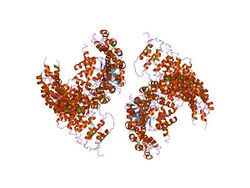Biology:B56 domain
| B56 | |||||||||
|---|---|---|---|---|---|---|---|---|---|
 crystal structure of protein phosphatase 2a (pp2a) holoenzyme with the catalytic subunit carboxyl terminus truncated | |||||||||
| Identifiers | |||||||||
| Symbol | B56 | ||||||||
| Pfam | PF01603 | ||||||||
| InterPro | IPR002554 | ||||||||
| SCOP2 | 1qq3 / SCOPe / SUPFAM | ||||||||
| TCDB | 5.A.4 | ||||||||
| |||||||||
Protein phosphatase 2A (PP2A) is a major intracellular protein phosphatase that regulates multiple aspects of cell growth and metabolism. Phosphorylation enables the activation or The ability of this widely distributed heterotrimeric enzyme to act on a diverse array of substrates is largely controlled by the nature of its regulatory B subunit. There are multiple families of B subunits, this family is called the B56 family.[1]
Function
Protein phosphatase 2A (PP2A) is a major intracellular protein phosphatase that regulates multiple aspects of cell growth and metabolism such as DNA replication, transcription, translation, cell cycle, development, and apoptosis.
In order to exhibit specificity control over catalysis, hetero-oligomers are formed so the catalytic subunits are complexed with regulatory subunits. This helps direct their action towards the cellular substrate. This is the function of the B56 domain.[2]
B56 alpha, is additionally thought to play a role in nuclear export.[3]
Structure
Regulatory B subunit is a heterotrimer.
Subcellular Localization
Mainly found in the cytoplasm, however various isoforms can be found in the nucleus.[3]
Isoforms of B56 protein family
- B56alpha
- B56beta
- B56delta
- B56epsilon
- B56gamma[3]
References
- ↑ "Identification of a new family of protein phosphatase 2A regulatory subunits". J. Biol. Chem. 270 (44): 26123–8. November 1995. doi:10.1074/jbc.270.44.26123. PMID 7592815.
- ↑ "The structure of the PP2A regulatory subunit B56 gamma: the remaining piece of the PP2A jigsaw puzzle.". Proteins 74 (1): 212–21. 2009. doi:10.1002/prot.22150. PMID 18618707.
- ↑ 3.0 3.1 3.2 "Nuclear export and centrosome targeting of the protein phosphatase 2A subunit B56alpha: role of B56alpha in nuclear export of the catalytic subunit.". J Biol Chem 285 (24): 18144–54. 2010. doi:10.1074/jbc.M109.093294. PMID 20378546.
External links
- Eukaryotic Linear Motif resource motif class DOC_PP2A_KARD_1
 |

